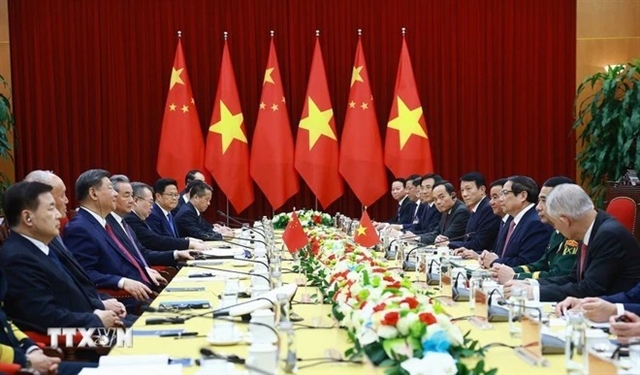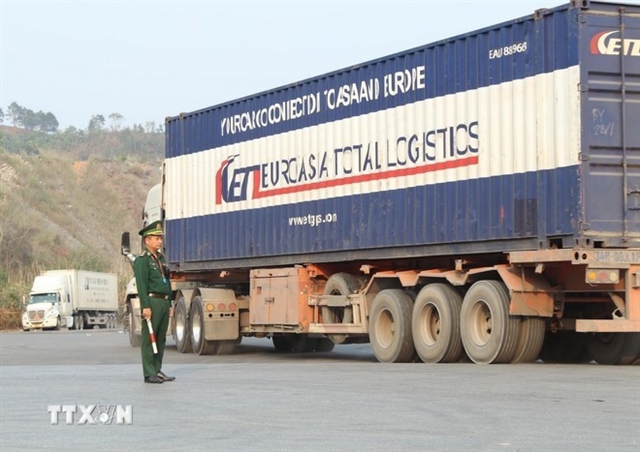PM’s Tianjin trip expected to bolster Việt Nam–China economic, trade cooperation
The Vietnamese PM left Hà Nội on June 24 morning for his four-day trip to China and attendance at the forum, which is taking place from June 24-26, at the invitations of Chinese Premier Li Qiang and WEF President and CEO Børge Brende.

HÀ NỘI — Prime Minister Phạm Minh Chính’s participation at the 16th Annual Meeting of the New Champions of the World Economic Forum (WEF) in Tianjin, China, reflects the Vietnamese Party and Government’s strong commitment to the Việt Nam–China comprehensive strategic cooperative partnership, while injecting fresh momentum into bilateral economic and trade cooperation amid a volatile global economic landscape.
The Vietnamese PM left Hà Nội on June 24 morning for his four-day trip to China and attendance at the forum, which is taking place from June 24-26, at the invitations of Chinese Premier Li Qiang and WEF President and CEO Børge Brende.
High political trust, thriving economic-trade cooperation
As close neighbours with deep historical ties, Việt Nam and China established diplomatic relations on January 18, 1950, and elevated their partnership to a comprehensive strategic cooperative partnership in 2008, the highest and most expansive form of diplomatic engagement Việt Nam holds.
In recent years, the bilateral relationship has remained on a positive trajectory, marked by several key developments. The state visit to Việt Nam by General Secretary of the Communist Party of China and Chinese President Xi Jinping and his spouse in December 2023 was a significant milestone, during which the two sides issued a Joint Statement pledging to deepen the comprehensive strategic cooperative partnership and build a Việt Nam-China Community with a shared future carrying strategic significance.
High-level exchanges remained active throughout 2024, including a state visit to China by Party General Secretary and State President and Tô Lâm (August 2024); an official visit to Việt Nam by Chinese Premier Li Qiang (October 2024); and two working trips by Prime Minister Phạm Minh Chính to attend the 15th Annual WEF New Champions Meeting in Dalian (June 2024), and to participate in key Mekong-region summits in China (November 2024).
Continuing into 2025, as both nations commemorate the 75th anniversary of diplomatic relations, engagement remains strong. Notable highlights include the phone talks between Lâm and Xi on January 15, the launch of the Year of Việt Nam–China Humanistic Exchange, and Xi’s fourth state visit to Việt Nam in April. These sustained interactions have reinforced political trust and cemented the foundation for long-term bilateral relations.
Strong political ties have catalysed robust economic co-operation. Việt Nam and China maintain regular economic dialogue mechanisms that have supported more balanced and sustainable growth in bilateral trade.
Trade remains a cornerstone of the relationship. Việt Nam is China’s largest trading partner in ASEAN and currently its fourth-largest trading partner in the word after the United States, Japan, and the Republic of Korea. China, in turn, is Việt Nam’s largest trade partner, biggest importer, second-largest export market, and third-largest foreign investor.

Bilateral trade reached US$205.2 billion in 2024. In the first five months of 2025, trade stood at $92.9 billion. As of January 2025, China’s total registered foreign direct investment (FDI) in Việt Nam amounted to $31.26 billion across 5,195 active projects, ranking sixth among 149 economies investing in the country. In 2024, China led in the number of new projects with 955 ones and ranked third in total registered capital with $4.73 billion, up 3.05 per cent. In the first five months of 2025, China remained third in newly registered capital, with $1.81 billion across 453 projects. Chinese investors are now present in 19 out of 21 FDI sectors and in 55 out of Việt Nam’s 63 provinces.
New impetus for deepening bilateral economic ties
Amidst increasingly comprehensive and substantive ties, PM Chính’s visit to Tianjin offers a valuable opportunity for high-level discussions on implementing shared strategic priorities and expanding economic co-operation.
Việt Nam’s Ambassador to China Phạm Thanh Bình noted that this is the first official visit by a senior Vietnamese leader to China in 2025. It follows closely on the heels of Xi’s successful visit to Việt Nam in April and coincides with the 75th anniversary of diplomatic relations and the ongoing Year of Việt Nam–China Humanistic Exchange.
According to Ambassador Bình, the visit reaffirms and advances the strategic understandings reached between the two nations’ top leadership. It also maintains positive diplomatic momentum, strengthens Việt Nam’s position in global cooperation platforms, and opens new avenues for sustainable national development.
He emphasised that, in a context of global economic volatility, both sides must expand and deepen the quality and effectiveness of practical cooperation. This includes implementing high-level consensus in areas such as investment, trade, and infrastructure connectivity; promoting Vietnamese exports, especially high-quality agricultural products, and prioritising major joint initiatives.
A key priority is the development of three standard-gauge railway lines linking the two countries, including Lào Cai–Hà Nội–Hải Phòng, Lạng Sơn–Hà Nội, and Móng Cái–Hạ Long–Hải Phòng. These projects are seen as flagship components of strategic infrastructure connectivity.
The two countries are also encouraged to promote Chinese investment in sectors where China holds strength and Việt Nam has demand, such as science and technology, innovation, digital transformation, green growth, and clean energy. Việt Nam’s young, dynamic workforce and emerging domestic market make it a strategic destination for global supply chain shifts. China, in turn, offers vast capital reserves, advanced technology, and a strong base of large enterprises.
Việt Nam and China should also leverage regional trade frameworks such as the Regional Comprehensive Economic Partnership (RCEP) and the upgraded ASEAN–China Free Trade Area (ACFTA 3.0) to ensure balanced trade growth. Strategic logistics and infrastructure connectivity should be enhanced through modernised cross-border rail links, smart border gate systems, and robust e-commerce and distribution networks.
With strong political will, complementary strengths, and a well-established diplomatic foundation, the Việt Nam–China partnership is poised to grow stronger—bringing shared prosperity to both nations and contributing to peace, stability, and sustainable development in the region and the world. — VNS
- Tags
- Việt Nam-China trade





